Positive Health Online
Your Country

The Four Pillars of Meditation
listed in meditation, originally published in issue 225 - October 2015
For many, the holy grail of meditation is the achievement of spiritual enlightenment, concerning which a vast amount of literature and folklore has passed from generation to generation as a revered legacy for as long as anyone can tell. This article describes the modern application of Lectio Divina an ancient monastic system that has evolved over many centuries and continues to evolve to meet the needs of succeeding generations.

Fig. 1. A flame in a windless place
As a system of spiritual development it was widely used in the pre-Christian era, and was employed extensively by the early Christian Church, which gave it the name Lectio Divina. In the 4th century it became a central discipline of the Levantine desert monastic communities, becoming in the 6th century one of the distinctive features of monastic life throughout the world. This application rests on four pillars: Self-Knowledge, Reflective thought, Therapeutic Meditation and Contemplation. In this tradition the spiritual path of spiritual enlightenment begins with Self-knowledge - a knowledge primarily acquired through education and Reflective Thought (Meditation).
The First Pillar - Self-Knowledge
Effective meditation requires some knowledge of the internal environment of the soul and its turbulent nature. There is good reason for this, for although it is accepted that we are spiritual beings, we are nonetheless subject to the natural forces that rule this world, which in a multitude of ways determines the bio-chemistry of our body and mind.
Most of us believe that we have the freedom to do whatever we choose, but that belief is a fallacy. To all intents and purposes just about everything we do in this world is conditioned and influenced by our internal and external environment. This not only includes our biology, which compels us to establish a place in the community, secure a career, and raise a family, but also involves our environment in the form of our families, our schooling, the community we live in, local and international politics, social role-models and expectations, food, climate, and so on. Clearly we do make choices, but they are conditioned choices. We are conditioned from the very beginning of our existence in the body. It is a conditioning that is reinforced moment by moment, nanosecond by nanosecond, and only when we accept this fact will we be able to progress with fulfilling our potential in life and with evolving spiritually.
Environmental Awareness (internal and external) is then fundamental to this work. It is an ‘awareness’ that enables us first to recognize, then to understand, and finally to control our biology, thereby stabilizing our psychology, because what we think and feel is determined by a biology conditioned by the environment. For this reason the initial focal point has long been the internal environment of the body and its chemistry; an ‘awareness’ of which is essential because without it our ability to engage in meditation will be erratic and confusing.
Biological Tension and Stress At a molecular level, matter exists in a natural and fluid state of tension that is established upon electromagnetic forces of attraction and repulsion. When this state changes, the effect can be very powerful and potentially destructive - that is to say, stressful - which in terms of human experience is usually associated with an increase rather than a decrease in tension. Certain situations are commonly understood to increase tension thereby generating stress. For example: the death of someone close, divorce or separation, moving home, financial insecurity, health problems, increased responsibilities, domestic strife, poor performance at work, child care issues, to name but a few.
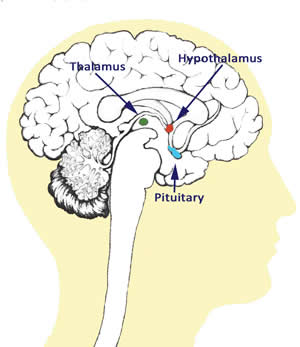
Fig. 2. Hypothalamus
Fight/flight mechanism A useful way of understanding this phenomenon is through being aware of the way the fight/flight Mechanism works. Our survival in this world is based upon our ability to respond to real or imagined threats. Typically, our ‘natural’ response to threatening situations is either to engage with them or to run away. This response is known as the fight/flight mechanism; it is our instinctive response to danger. In simple terms this mechanism is governed by the hypothalamus, an area of the fore-brain that controls the action of the pituitary gland, which forms the primary link between the endocrinal glandular system and the autonomic nervous system through which it directs our ‘fight or flight’ response.
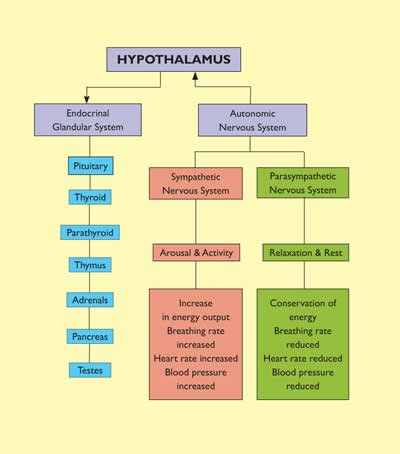
Fig 3. Autonomic Nervous System
The autonomic nervous system consists of the sympathetic, parasympathetic, and enteric nervous systems, of which the sympathetic and parasympathetic are the main focus of this discussion.
The sympathetic nervous system serves the fight/flight mechanism. It initiates a state of arousal and activity that stimulates movement concerned with survival; including stopping digestion, opening the airways of the lungs and increasing heart rate and blood pressure (It makes us tense).
The parasympathetic nervous system is the counterbalance to the sympathetic nervous system. It is responsible for maintaining and conserving the body’s resources. It regulates physiological maintenance, including processes such as cell growth, digestion, relaxation and sleep. Its function includes the storage of vital resources, promoting digestion, the distribution of nutrients, the constriction of bronchi and the slowing of respiration and the decrease of heart rate and blood pressure (It enables us to relax).
Hormones The triggers which activate these systems are hormones, which are chemical messengers secreted by the endocrine glands directly into the bloodstream, where they circulate throughout the body in very low concentrations affecting the activity and behaviour of cells. They can either stimulate the sympathetic nervous system to arouse the body (towards fight or flight), or the parasympathetic nervous system to calm the body. The endocrinal glands are the Pineal, Pituitary, Thyroid, Parathyroid, Thymus, Adrenals, Pancreas, and Gonads (ovaries or testes).
The most notable feature of the sympathetic nervous system is rapid and/or shallow breathing. In contrast, the main characteristic of the parasympathetic nervous system is a slowing down and deepening of the breathing. Learning to use the way we breathe to control this mechanism is fundamental to creating the stable biological platform needed for effective meditation. It is not difficult to engage with - the key to activating it is simply through gently slowing down and deepening our breathing. This applies particularly to the way we manage anxiety and stress.
Anxiety and Stress The term anxiety is commonly used to describe a subjective experience of a negative state of being that is often expressed emotionally. Anxiety is typically perceived and expressed in terms of feelings (tears, fear, aggressive and reactive outbursts etc.). For example, a rumour of an imminent redundancy may be perceived as a threat to our domestic security. The negative connotation of such a rumour means that our breathing will probably increase and the sympathetic nervous system (fight/flight mechanism) will engage, resulting in hormones such as cortisol, epinephrine and adrenaline, being released into the bloodstream as we anticipate a possible ‘danger/threat’, inducing an emotionally charged state of mind.
Faced with an imminent life-threatening situation a fight/flight response would be immediate and natural and desirable, however, faced with a persistent rumour of redundancy, the continued presence of such hormones would reinforce our negative interpretation of the situation and exacerbate our negatively charged thoughts and feelings. For many reasons, such a situation is neither wholesome nor desirable. Anxiety, then, is a good indicator of the presence and activity of the Fight/Flight mechanism. Therefore, recognizing this mechanism is an important step because once identified it is possible to modify and control it.
Modifying this mechanism is not difficult. It is achieved first through slowing down the rate and depth of breathing. This simple action is a powerful tool that allows us to regulate both the autonomic nervous system and the endocrines, enabling us to avert a negative response to a given situation. Second, by preventing or minimizing such a response we provide a window of opportunity to introduce a more positive response through thinking positively (See affirmations below). Used in conjunction with a suitable method of relaxation, it is a very effective tool for reducing anxiety and controlling the ceaseless pageant of thoughts, feelings and images that constitute our chemistry of consciousness. There is nothing new in this, breath control and the use of positive thought have been central to meditation for millennia.
Relaxation Anyone seeking to become proficient in the art of meditation must acquire some skill in relaxation because as we have seen, effective meditation requires a stable biological platform. Since relaxation is the first step towards creating that stable platform it is important that the basic skills of relaxation are acquired. Whatever method of relaxation is employed, and there are many to choose from, the key lies in combining relaxation with the regulation of the breath, for it is with and through the breath that effective control over the tensions within both the body and the mind can be established. A slow rate of gentle deep breathing (approximately 8 – 12 breaths a minute), will generally induce a parasympathetic nervous system response.
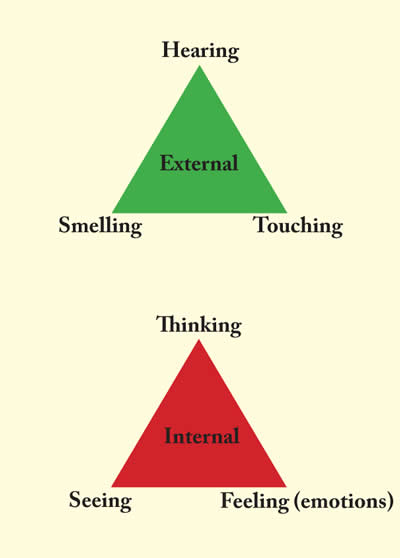
Fig. 4. Self-Examination
The Second Pillar - Reflective Thought
Our success in Reflective thought is established upon the platform of knowledge acquired in the work of the first pillar. It is a process of developing an understanding of ‘Self’ in the context of our environment. Apart from ‘Self’ there is no permanent reference or focal point, thus we must begin with Self, with who and what we think we are; it is axis about which our reflections turn. That we are driven and conditioned by the chemistry of the body and its environment suggests that as the physical and environmental conditions change so will we. It is then important that we recognize the influence of the transient nature of the external influences that determine our state of being and perception of’ Self’. There are various exercises within the parameters of this Pillar designed to enable us to distinguish between external sensory awareness and the internal chemistry of consciousness; with the emphasis being upon noting how our personality and moods vary in relationship to our daily experience. Two examples follow:
1. Self-examination - Reflection on the Day’s Events
In a state of relaxation, focus your attention upon the day’s events, scan through the day noting the activities that were significant. First, note those events where you may not have functioned well. Second, examine each event, noting what you might have done that may have been more appropriate. Third, examine each event; note what others involved might have done that may have been more appropriate. Fourth, establish what it was about each event that you could not have changed. Fifth, note those events where you functioned well. Sixth, note and reflect upon how you feel about the day (are you tired, frustrated, happy etc.). Record your impressions in a notebook; they will be invaluable as time progresses
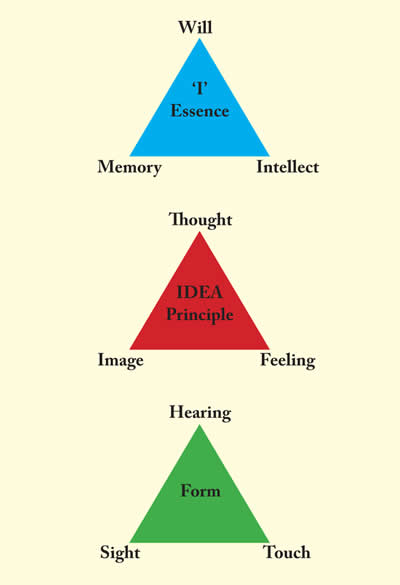
Fig. 5. Transient Self II
2. Transient Nature of Self
In this exercise we are directed to observe and reflect upon the nature of experience in three modes. The lowest triad refers to our experience via the senses; the second triad denotes the chemistry of consciousness via our thoughts, imagination and feelings. The third alludes to the more permanent aspect of ‘Self’ in the Will, Intellect and Memory. The Will leads us to consider the distinction between desire and duty; Intellect introduces us to our faculties of reason, wonder and imagination; Memory draws our attention to our ability to record, retain and recall experience. Three points of interest arise in this exercise. The first is the ‘awareness’ itself of these areas of activity, the second is the transient nature of much of that activity, and third is the growing recognition of a permanent aspect of ‘Self’ implicit in this field of experience. It is the distillation of the permanent Self that is the main objective of this exercise. Again, record your impressions in a notebook.
The Third Pillar - Therapeutic Meditation
Therapeutic meditation is not designed to be a religious or spiritual process, although it may be used as such or function as a vehicle for spiritual healing. Therapeutic Meditation is essentially a method of establishing health affirming thought-patterns and ideas, and, of generating endorphins for the purpose of restoring good health in body mind and soul. The process rests upon establishing a peaceful and restorative state of being through:
a) Engaging the Parasympathetic Nervous System which regulates the conservation of energy, Physiological maintenance, Cell growth, Digestion & the distribution of nutrients, Relaxation & Sleep. This is achieved primarily through the use of the breath and relaxation;
b) Generating Endorphins, which are morphine-like hormones secreted into the bloodstream. Endorphins function as pain regulators and help to lower blood pressure. They are also involved with stimulating an overall sense of well-being, appetite modulation and the release of hormones such as oestrogen, progesterone, testosterone and DHEA. This is achieved primarily through the use of the imagination, supported by appropriate music essential oils etc;
c) Developing health affirming thought-patterns through the use of affirmations, which are conscious assertions such as “I like tea”. Affirmations influence our thinking and clearly some of our thoughts are negative. Unfortunately, every negative thought or word constitutes a negative affirmation, and because we are frequently emotionally attached to them we find them easy to live with. Negative thought-patterns influence the way we think and feel about things, therefore, replacing them with more constructive beliefs and ideas through the use of positive affirmations will effect positive change in our everyday life. Positive affirmations are typically short positive statements used to replace negative beliefs and attitudes. Designing and using a positive affirmation is more than constructing a sentence and repeating it. It is a process that begins with developing an awareness of the way we think and the attitudes that condition our everyday life. A good affirmation is achieved by carefully reflecting upon the objective of the therapy and tailoring the affirmation to meet that objective.
There are various ways of using an affirmation, to keep it at the forefront of the mind; a common practice is to utter the affirmation out loud (privately or publicly) or to sing it. Another approach, particularly in a group setting, is to use it as a musical round. As such it can be a very powerful tool. Another effective way of keeping an affirmation at the forefront of the mind is to write it down; leave a note in a conspicuous place where you will notice it throughout the day.
The Fourth Pillar - Contemplation
In this tradition Contemplation means abiding in the Presence. How this is achieved is via a simple yet effective method that has been universally employed since ancient times. It is a method known as The way or The ladder. Adopted by the Order of St Benedict in the sixth century, it came to be known as Lectio Divina or divine reading, and as such was used within monastic houses specifically for the study of the Scriptures and as a basis for a graduated system of prayer and meditation that led towards contemplation. This ancient spiritual discipline was well known in the classical world, albeit in different forms. In simple terms this ancient spiritual discipline consists of the slow repetitive reading of a passage of Scripture followed by meditating deeply about its significance and responding to any inspiration that may emerge from the meditation.
Traditionally, the reading, or Lectio, is spoken aloud and repeatedly, with the emphasis upon the act of listening. In times past this phase could last several hours, but today ten to fifteen minutes is usual. In Lectio listening means attending with the whole of one’s mind, engaging as much of one’s being in the reading as possible, thereby cultivating the ability to perceive something of the soul of the text. This attending is followed by, and extends into a period of thinking about the subject matter of the reading and as such is called Meditatio or meditation. The response to the Meditatio varies, but often took the form of spontaneous extemporary prayer, singing or inspired writings. This is known as Oratio.
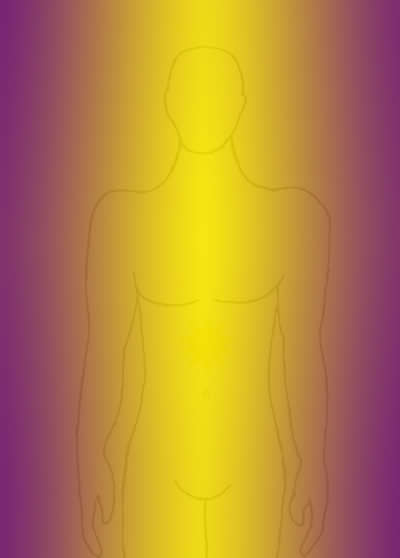
Those who have persevered with this discipline have found that the Oratio often subsides into a profound state of quiet that has been known to transform into a state of “peace that passeth all understanding”. This state of being is traditionally called Contemplatio or contemplation. It has been described by those who have experienced it as dwelling in the Presence of God. Thus Lectio Divina has been central to the Western discipline of spiritual development and in a variety of forms remains so today. Clearly the language has evolved, as have the ideas and terms that express those ideas, for they have of necessity adapted to the needs of each succeeding generation, both spiritual and secular, and doubtless, this progression will continue.
finis
Comments:
-
No Article Comments available